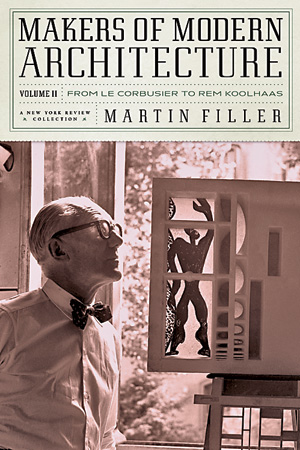
A Voice for Here and Now
George Baird
Architecture Record
September 16, 2013
Makers of Modern Architecture (Volume II): From Le Corbusier to Rem Koolhaas
By Martin Filler. New York Review Books, 2013, 336 pages, $30.
Martin Filler's new collection of essays appears in the wake of a significant shift in the tenor of architectural criticism. Gone are such provocative, if “unstable” (Filler's word), figures as Herbert Muschamp, and such cheerleaders for the star system as Nicolai Ouroussoff. Instead, we have their more measured successor at The New York Times, Michael Kimmelman, as well as the similarly thoughtful Christopher Hawthorne at the Los Angeles Times and Blair Kamin at the Chicago Tribune.
But Filler can claim to have launched the new tone, and a new social orientation to architectural design. Since he began writing for The New York Review of Books in 1986, he has commented on historical figures as well as contemporary ones, more famous as well as less famous ones, and individual architects as well as teams. In his previous volume (2007), he was particularly interested in resurrecting the reputations of women designers, such as Ray Eames, whose male collaborators overshadowed them. He has a keen interest in the relationship between the personal histories of his subjects and their career successes and failures. This critical-biographical approach is most successful in the current volume—which like the earlier one features mostly reworked essays from The New York Review of Books—in pieces on Oscar Niemeyer, Edward Durell Stone, and Eero Saarinen. For example, he notes: “Niemeyer led an eight-decade-long samba through the building art, a joyous journey that gave the world some of its liveliest modern landmarks.” As for Saarinen, he observes, “Although he has been accused of some of the same tendencies now held against Calatrava—particularly a fondness for ostentatious engineering displays, when simpler solutions would suffice—Saarinen, even at his shallowest, had far more depth than Calatrava.”
On Frank Lloyd Wright and Le Corbusier, however, I find that Filler's biographical interests overwhelm his critical ones, and the actual buildings get short shrift. He justifies his approach to these figures by saying that in the earlier volume he “discussed both more generally.” But this fails to persuade me that such almost gossipy texts belong in a collection of architectural criticism.
Having said this, the strength of Filler's writing has steadily grown over time and reached a new plateau in his fierce attack (too recent to be included in this book) on MoMA's plan to demolish Tod Williams Billie Tsien's Museum of American Folk Art. MoMA has subsequently backed off and promised to explore alternatives. It is hard to imagine that Filler's voice did not have a significant effect on the situation. It seems to me that he can now lay claim to the mantle of the late Ada Louise Huxtable, the most admired critic of recent times.
